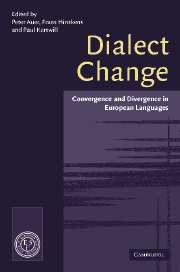Book contents
- Frontmatter
- Contents
- List of maps
- List of figures
- List of contributors
- Preface
- Map
- 1 The study of dialect convergence and divergence: conceptual and methodological considerations
- Part 1 Convergence, Divergence and Linguistic Structure
- 2 Internal and external factors in phonological convergence: the case of English /t/ lenition
- 3 Dialect/standard convergence, mixing, and models of language contact: the case of Italy
- 4 Convergence and divergence in grammar
- 5 Phonology, grammar, and discourse in dialect convergence
- Part 2 Macrosociolinguistic Motivations of Convergence and Divergence
- Part 3 Microsociolinguistic Motivations
- References
- Index
2 - Internal and external factors in phonological convergence: the case of English /t/ lenition
Published online by Cambridge University Press: 22 September 2009
- Frontmatter
- Contents
- List of maps
- List of figures
- List of contributors
- Preface
- Map
- 1 The study of dialect convergence and divergence: conceptual and methodological considerations
- Part 1 Convergence, Divergence and Linguistic Structure
- 2 Internal and external factors in phonological convergence: the case of English /t/ lenition
- 3 Dialect/standard convergence, mixing, and models of language contact: the case of Italy
- 4 Convergence and divergence in grammar
- 5 Phonology, grammar, and discourse in dialect convergence
- Part 2 Macrosociolinguistic Motivations of Convergence and Divergence
- Part 3 Microsociolinguistic Motivations
- References
- Index
Summary
Introduction: Phonological Variation and Linguistic Theory
In trying to understand the dynamics of dialect convergence and divergence, we are faced with two sets of problems that are rarely reconciled. One set pertains to the social factors that operate in the initiation, actuation, and diffusion of linguistic variation and change. Viewed as social processes, dialect convergence and divergence can easily be understood as the outcome of speakers' activity, either in the short term as the result of variations which arise in direct, face-to-face communication, or in the long term as the outcome of a process in which patterns of social interaction lead to changes in the linguistic norms of the entire speech community (but cf. Auer and Hinskens, this volume). Viewed in this way, changes in the linguistic system arise from changes in the speech patterns of speakers (see Milroy and Milroy 1985 for further discussion). A second set of factors, however, can also be compelling. If we assume that knowledge of a language is knowledge of an abstract system of rules which operates irrespective of the context of performance, it should equally be possible to bracket out the social dimension and understand dialect convergence and divergence as internally motivated processes that stem from deep-seated general principles such as universal constraints on markedness.
- Type
- Chapter
- Information
- Dialect ChangeConvergence and Divergence in European Languages, pp. 51 - 80Publisher: Cambridge University PressPrint publication year: 2005
- 9
- Cited by



